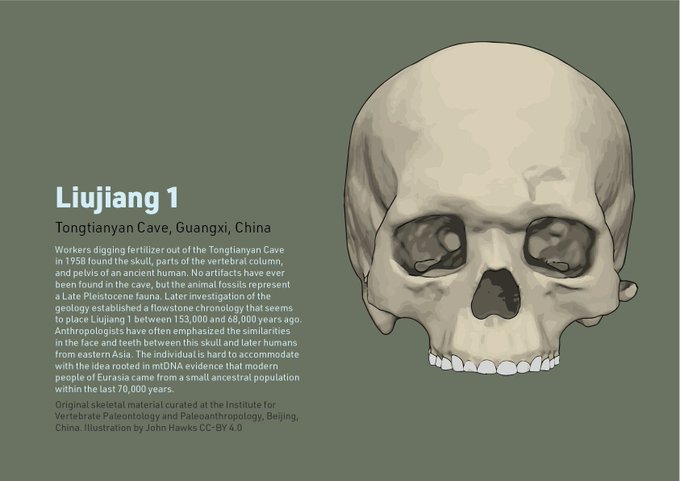ANTHROPOLOGYのTwitterイラスト検索結果。 393 件中 11ページ目
Beastopia Covers
•
•
•
#art #illustration #ArtistOnTwitter #artist #commissionsopen #artistsontwitter #ibispaint #procreateart #shiraworld #Anthropology #anthro #drawing
Paranthropus boisei is one of the best-known fossil #hominin species. Part of a branch that existed for more than 1.5 million years, adults could generate incredible bite force--shown by the huge area for the temporalis muscle. #paleoanthropology #FossilFriday
wip--
fun fact of the day because i drew this during anthropology class is that ethnographic fieldwork (an extended encounter with a group or community with the intention of learning/documenting their "culture") is sometimes referred to as "deep hanging out" https://t.co/zf5OK4BDXf
Ralph von Koenigswald took pains to hide fossil #hominin remains during World War II, but the Japanese occupation army selected Ngandong 10 "as a birthday present for the Japanese emperor and kept in the Imperial palace of Kyoto" (as recounted by Teuku Jacob) #paleoanthropology
Few fossil #hominin samples preserve evidence of the postcranial skeleton in abundance, but Homo naledi from the Dinaledi Chamber is one of them. These fossils are only around 250,000 years old, but the scapula resembles some of the earliest known hominins. #paleoanthropology
One of the branches of the #hominin tree can be traced today as far as 4.1 million years ago, at Kanapoi, Kenya. Here, the track becomes unclear. What was the origin of the Australopithecus line, and how does it connect to fossils like Ardipithecus? #paleoanthropology
For more than 100 years, the remains of a Neandertal child lay unrecognized in Belgium after being unearthed in 1829. Much of the child's context was lost in excavation, but today Engis 2 is crucial evidence about growth and development in #paleoanthropology #hominin
The Iron Age Tribes of Britain https://t.co/FUzV4dq7AF #archeology #anthropology #history
When I turned to #paleoanthropology, I knew that teeth made up a disproportionate amount of the record, but I couldn't imagine I would ever be very interested. What fascinates me now are the clues they give about an individual #hominin's life course.
Paranthropus aethiopicus is one of the fossil #hominin species that may be a "nomen dubium". The holotype specimen is Omo 18-18, a jaw that lacks any tooth crowns. What remains isn't distinct from large samples of P. boisei or P. robustus. #paleoanthropology
Quite a lot of evidence now suggests ancient people usually classified as "modern" humans were in China before 68,000 years ago. None are as telling as the Liujiang individual, which shows anatomical similarities with more recent people of the area. #paleoanthropology #hominin
The perils of understanding extinct populations with morphology are front and center with the Arago #hominin sample. Were they early Neandertals, or something else? My guess is a mosaic of drift in ancient Eurasian populations. #paleoanthropology
Some parts of the skeleton are very rare in the #hominin fossil record. The hand remains of Homo naledi, including this articulated specimen, tell us much about the tool-using potential of this species, while suggesting it was a great climber. #paleoanthropology
Ancient DNA Reveals Secrets of Dire Wolves https://t.co/OREGPMTtCc #archeology #anthropology #history
Hello, I am Wenpei. A Chinese illustrator, animator, and writer based in NY. I write a non-fiction story and make my second animation now. I'm interested in anthropology. Many of my ideas are from it. Hope to use my hands to tell interesting stories! #PortfolioDay
Some fossil #hominin skulls have an important place in understanding the variation of extinct species. Stw 505 is a large Australopithecus africanus skull, helping to show that big individuals had brains that overlapped in size with the larger-brained Homo. #paleoanthropology
Students of #hominin evolution quickly pick up the differences between big-toothed Paranthropus boisei and our genus, Homo. Yet there are still anatomical overlaps between these lineages that make some of the fossils from Koobi Fora challenging to interpret. #paleoanthropology
Sobs they don't even look like their canon appearances,,
Anyways considering making this a series but uhh have timeskip fujiyuri where fujisaki teaches psychology at a local community college and yuri does something cool like anthropology 😎
Could Australopithecus have been the first hominin genus to migrate out of Africa? We haven't found them in Eurasia yet, but this specimen from Chad suggests that they were widespread far from the East African rift and South African caves. #hominin #paleoanthropology
Fossils of Australopithecus and Homo were all obligate bipeds, but their pelvic remains do exhibit some differences. Australopithecus sediba blurs the boundary. With its Homo-like pelvis, this species may be a closer human relative. #hominin #paleoanthropology































